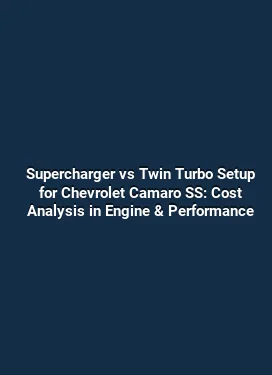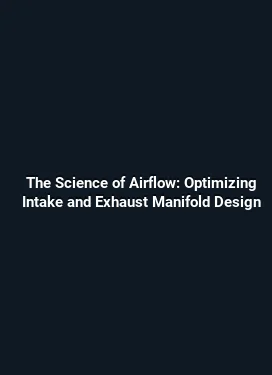Electric Performance Boosters: The Rise of E-Turbos and E-Superchargers
In the pursuit of stronger horsepower, faster throttle response, and cleaner emissions, automotive engineering has embraced electric-assisted forced induction. E-turbos and e-superchargers represent a class of devices that augment traditional turbochargers and superchargers by leveraging electric motors to spool, pre-boost, or assist boost pressure. This technology enables more precise control over boost curves, minimizes lag, and can improve drivability across a wider range of operating conditions. The result is a modern propulsion approach that blends internal combustion efficiency with electrical performance, delivering tangible benefits for enthusiasts and daily drivers alike.
Understanding the Core Concepts: How Electric Boosters Work

Traditional turbochargers rely on exhaust gas energy to spin a turbine that compresses intake air. This energy source is inherently variable, leading to turbo lag and a boost delay at low RPMs. Electric boosters introduce an electric motor-driven component to either assist the compressor directly or to spin the turbocharger faster when exhaust energy is insufficient. There are two prevailing configurations: electric-assisted turbochargers and electric-assisted superchargers, each with distinct advantages.
Electric-Assisted Turbos

In an electric-assisted turbo, a motor and integrated power electronics can pre-spool the turbo prior to exhaust gas flow. This way, when the driver asks for torque, the system has already elevated the turbine speed, reducing lag and delivering quicker throttle response. The motor may engage at low to mid RPMs, then hand over to exhaust-driven boost once there is sufficient energy in the exhaust stream. This results in a flatter torque curve and more linear power delivery, especially in sporty or performance-oriented driving scenarios.
Key design considerations include heat management, motor size, and control software that coordinates electrical assist with exhaust-driven boost. Properly tuned, an electric-assisted turbo can unlock earlier torque without sacrificing top-end power. Practically, drivers notice crisper throttle response and more immediate acceleration as the engine reaches its boost threshold with less delay.
Electric-Assisted Superchargers
A traditional supercharger is belt-driven from the crankshaft, delivering instantaneous boost but at the cost of parasitic power loss. An electric-assisted supercharger uses an electric motor to spin the compressor, providing immediate boost independent of engine speed. As the engine builds RPM, the system can switch to conventional mechanical drive or maintain an optimized blend that minimizes parasitic losses while preserving the benefits of immediate torque.
Because electric assistance can fill the gap at low to mid RPMs and then transition to mechanical drive at higher RPMs, the overall intake pressure stability improves. This is particularly advantageous for engines with aggressive cam timing or high compression where responsive torque matters most for driving dynamics and handling characteristics.
Performance Benefits: Why Electric Boosters Matter
Electric booster systems influence several performance facets, from throttle feel to fuel economy and emissions. The most noticeable gains come in three areas: throttle response, broad torque delivery, and engine efficiency. However, the exact outcomes depend on the vehicle architecture, the control strategy, and how the system integrates with other powertrain components.
Throttle response and response weight: With instant electrical assistance, the engine responds quicker to driver input, reducing perceived lag. This translates to a more confident driving experience in urban traffic and on winding roads where quick throttle modulation is desired. Torque is available earlier in the rev range, enabling smoother launches and more controlled roll-on acceleration.
Torque band widening: Electric assist smooths and broadens the torque curve, especially at low to mid RPMs. Engines that rely on aggressive turbo spooling can deliver a stronger mid-range without resorting to higher RPMs, which often helps in passing scenarios and overtaking maneuvers with less gear hunting and smoother power delivery.
Overall efficiency and emissions: The technical synergy of electrical assistance with internal combustion can lead to better thermal efficiency and potentially lower emissions under certain driving conditions. When the system reduces throttling losses and optimizes boost, it can contribute to improved fuel economy in everyday driving and a more favorable pressure-volume work balance in high-load situations.
Integration and Control: Engineering the Perfect Balance
Integrating electric boosters into a modern engine requires careful packaging, control algorithms, and thermal management. The goal is to deliver seamless, transparent performance enhancements without imposing excessive parasitic losses, electrical demands, or reliability concerns. Here are the critical aspects of a thoughtful integration process.
Powertrain Synergy and Calibration
Engine calibration is the nerve center of a successful e-boosting system. Calibration aligns motor torque delivery, boost pressure targets, exhaust energy usage, and engine fueling with the vehicle’s drivetrain characteristics. Calibrations consider transmission behavior, launch control strategies, and the vehicle’s overall weight distribution to ensure boosts occur at the most opportune moments.
In practice, engineers craft boost maps that predict when electrical assist should engage, how aggressively to spool, and how to transition to conventional boost modes. The result is a powertrain that feels naturally responsive, without abrupt surges or abrupt torque spikes that could unsettle the chassis or braking dynamics.
Thermal Management and Reliability
Electric boost components generate heat, particularly when the motor is actively spinning under high loads. Effective cooling strategies, including dedicated coolant loops, heat exchangers, and thermal insulation, are essential to prevent heat soak from compromising performance or component life. Reliability hinges on robust insulation, fault-tolerant electronics, and durable bearings that can withstand the rigors of constant boost cycles.
Additionally, the electrical system must be designed to handle peak current demands without affecting other vehicle systems. This can involve high-capacity batteries, capacitors for transient power, and resilient wiring harnesses that resist heat and vibration. In performance-oriented setups, safety margins in the electrical design help preserve long-term reliability even under spirited driving conditions.
Practical Setup: From Concept to Road Experience
Implementing e-turbo or e-supercharger technology is not purely theoretical. Enthusiasts or engineers aiming to retrofit or upgrade their platforms should consider several practical steps, balancing performance goals with budget, legality, and reliability. The following sections outline actionable guidance and considerations based on real-world scenarios.
Assessing Vehicle Compatibility
Not all engines are equally suited for electric boost integration. Key compatibility factors include engine displacement, compression ratio, fabrication space for additional hardware, and the presence of space within the intake tract for the added compressor hardware. Modern engines with advanced knock control and flexible engine management tend to be more adaptable to electric-assisted boost technologies. Before committing to a kit, a thorough assessment of the engine’s current boost strategy, cooling capacity, and electrical architecture is essential.
Choosing Between E-Turbo and E-Supercharger Paths
The decision between an electric-assisted turbo and an electric-assisted supercharger often hinges on the vehicle’s intended use and the desired delivery characteristics. E-turbos excel in maintaining efficiency and broadening the torque band without sacrificing high-end power, making them attractive for performance sedans and sportier SUVs. E-superchargers provide the most immediate throttle response and can be simpler to implement in naturally aspirated or lightly turbocharged platforms, offering a direct feel of instant torque at low RPMs.
For performance-focused builds, combining both approaches with an intelligent control strategy can yield the most balanced outcome: rapid response at low RPMs, strong high-end torque, and efficient operation across the RPM range.
Maintenance and Real-World Durability
Maintenance considerations for electric boost systems include routine inspection of motor bearings, pump seals, and cooling system integrity. Electrical components should be monitored for signs of wear, insulation breakdown, or temperature excursions. Periodic software updates from the supplier or tuner can optimize performance, adapt to fuel quality variations, and fine-tune boost thresholds for different driving modes. Real-world durability tests across diverse climates help ensure long-term reliability and consistent performance under varying loads and temperatures.
Driving Dynamics: How Electric Boost Changes the Ride
Beyond raw numbers, electric boosters reshape the driving feel. The most immediate improvement is throttle modulation: drivers experience a more linear, predictable response that reduces the sensation of turbo lag. This can improve corner exits, overtakes, and overall confidence on curvy roads. In assisted configurations, the vehicle is more forgiving at the limit because the system compensates for small throttle jitters with smooth pressure regulation.
In track or sport settings, the benefits become more pronounced as the boost strategy can be tuned to deliver peak torque within a wider RPM window, enabling consistent cornering lines and better exit acceleration. For daily driving, the system can optimize fuel efficiency by delivering boost only when necessary, avoiding unnecessary energy consumption while preserving strong performance when requested.
Future Trends: The Next Step in Electric Boosting
As electrification accelerates, e-turbos and e-superchargers are likely to become more integrated with holistic powertrain systems, including advanced battery management, predictive control, and vehicle-to-grid capabilities. Expect smarter thermal models, improved waste heat recovery integration, and multi-source boost strategies that seamlessly blend electrical and exhaust energy. Manufacturers may also explore modular, swappable boost units that allow enthusiasts to tailor a vehicle’s performance profile for track days, daily driving, or a combination of both.
Key Takeaways for Enthusiasts and Technicians
Electric performance boosters represent a practical evolution in engine technology, delivering quicker response, more flexible torque delivery, and the potential for improved efficiency. The most successful implementations hinge on thoughtful calibration, robust thermal management, and a drive philosophy that harmonizes electric assistance with traditional internal combustion dynamics. For technicians, mastering the balance of electrical and mechanical systems, as well as the associated software controls, is essential to unlock the full benefits while preserving reliability and safety.
With ongoing developments in power electronics, energy storage, and motor efficiency, the role of e-turbos and e-superchargers is set to expand across a wider range of vehicles, from compact hot hatches to high-performance luxury sedans. As the landscape evolves, drivers can anticipate even more refined throttle behavior, stronger mid-range torque, and a driving experience that blends the immediacy of electric torque with the enduring character of internal combustion engines.






